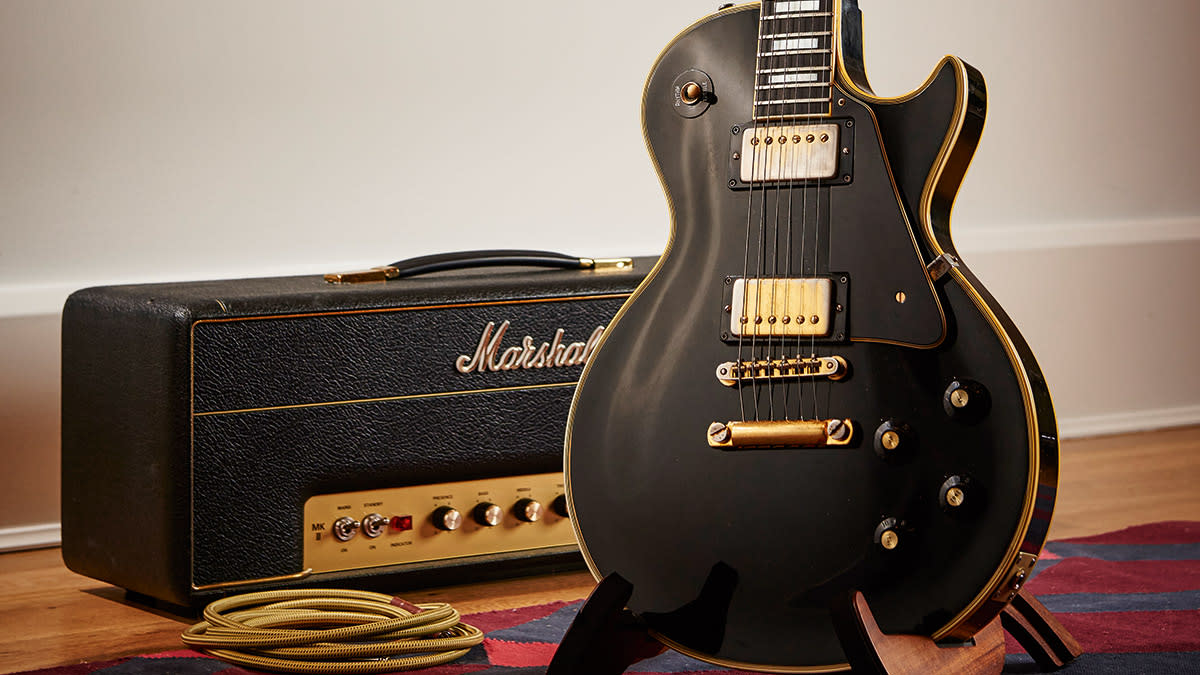The evolution of the late-‘60s Gibson Les Paul Custom – a near “exact duplicate of the original” that has become a holy grail for collectors

Gibson’s debut solidbody electric guitar line was introduced in 1952 with the Les Paul model (dubbed the ‘Goldtop’ on account of its gold finish).
The range was expanded in 1954 with the Les Paul TV and Junior student guitars along with the price-list-topping, Ebony-finished Les Paul Custom. The mid-priced Les Paul Special was added the following year.
At this stage, Les Paul Customs featured an Alnico V pickup in the neck position paired with a P-90 in the bridge position, while all other Gibson Les Paul guitars were fitted with P-90s only. From 1957, Customs were fitted with a trio of PAF humbuckers (rarely two), while the Goldtop received a dual set.
The next year, the Les Paul model was renamed the Les Paul Standard and decked out in its now iconic Cherry Sunburst finish. But the Standard would only be in production from 1958 to 1960, when it was radically overhauled into the SG-style double-cutaway design. Customs followed suit in 1961, appearing in a white finish yet retaining their triple-humbucker configuration.
The demise of the single-cutaway Les Pauls in the early '60s was attributed to poor sales. Furthermore, from the late '50s, Gibson placed great emphasis on electric guitar designs that improved access to the upper frets, as evidenced by its modernized 1958 unveilings that included the ES-335, EB-2, Explorer, Flying V, and double-cutaway TV and Junior Les Pauls.
Advertised as a “new, revolutionary body design”, the “fretless wonder” Les Paul Custom was renamed the SG Custom in 1963. SG (solid guitar) models generally sold well. But at the same time, a demand for the old-style Les Pauls was growing. Seen in the hands of guitar heroes from the mid-'60s onwards, single-cutaway models were increasingly sought out by players, and Gibson took note.
In 1968, Gibson reintroduced the single-cutaway Les Paul design in two guises: the Les Paul Standard and Les Paul Custom. With its gold finish and P-90 pickups, this Les Paul Standard differed considerably from its ’Burst namesake model that was in production from 1958 to 1960, and was supplanted by the mini-humbucker-loaded Les Paul Deluxe in 1969.
The Deluxe became a classic in its own right during the hard-rock era of the '70s but was discontinued in the mid-'80s. Additionally in ’69, with Les Paul himself now back onboard, Gibson expanded the single-cutaway line to include the short-lived Professional and Personal guitars (superseded by the Recording model in 1971). However, the most successful of all was the Custom. In fact, Gibson shipped more in ’69 alone than it did throughout the entire '50s.
Though Gibson touted the late-'60s Les Paul Custom as an “exact duplicate of the original,” it differs significantly from the '50s guitars. The most obvious difference is that it came fitted with two humbuckers as standard. But less apparent is that underneath its Ebony finish lies a maple cap (earlier variants were constructed of mahogany only).
Another important distinction is the headstock angle, which by this stage had been decreased from 17 to 14 degrees. Unique in construction, late-'60s Les Pauls are coveted by collectors and are now commanding five-figure sums on the vintage market.
The late-'60s Les Paul Custom: A timeline
1952: Les Paul model released; single‑cutaway body;
2x P-90 pickups; gold finishLate 1953: Les Paul Custom prototypes
1954: Les Paul Custom released; single-cutaway; 1-piece mahogany body; Alnico V (neck) and P-90 (bridge) pickups; black finish
1957: 3x humbuckers
1961: Double-cutaway SG-style mahogany body; 3x humbuckers; white finish
1968: Single-cutaway; 1-piece mahogany body with maple top; 1-piece mahogany neck; 2x humbuckers; black finish
1969: 3-piece mahogany neck; shorter neck tenon
Late 1969/Early 1970 (Norlin era): Laminated ‘pancake’ body with maple top; neck volute
1972: Les Paul Custom ’54; Alnico V (neck) & P-90 (bridge) pickups; black finish
1974: ‘Twentieth anniversary’ 15th fret inlay


